Outdoor fans repel mosquitoes by creating airflow that mosquitoes can’t navigate through as they’re weak flyers. The moving air disrupts their flight patterns and scatters the carbon dioxide you exhale, which is their primary method for finding you. Fans with higher CFM ratings (1,000+) work best by creating stronger air movement that prevents mosquitoes from landing on your skin. Learn how strategic fan placement can maximize your mosquito-free zone.
The Science Behind Mosquito Flight and Wind Resistance
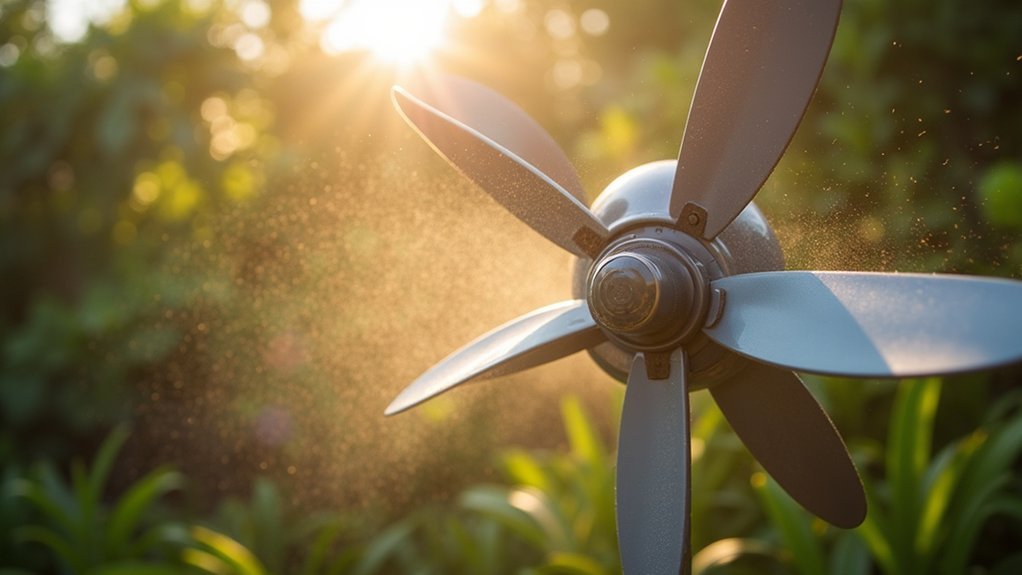
While mosquitoes excel at finding human targets, they’re surprisingly vulnerable to something as simple as a breeze.
These tiny insects may be persistent, but they’re actually weak flyers that struggle considerably when facing airflow resistance.
When you set up outdoor fans in your space, you’re creating an environment that mosquitoes physically can’t navigate. The continuous airflow disrupts their flight patterns, preventing them from maintaining a steady course toward you.
Additionally, fans scatter the carbon dioxide you exhale—the primary signal mosquitoes use to locate you.
Research confirms that strategically placed outdoor fans with higher CFM ratings effectively reduce mosquito presence.
The stronger the airflow, the more difficult it becomes for these pests to approach, land, and bite, giving you a simple yet scientific solution to enhance your outdoor comfort.
How Air Movement Disrupts Mosquito Hunting Patterns
When you set up outdoor fans, you’re actively disrupting mosquitoes’ hunting patterns by creating air currents they can’t effectively navigate through.
Your fan’s breeze scatters the carbon dioxide you exhale, making it harder for mosquitoes to detect your presence since they primarily track this gas to find hosts.
The moving air also creates physical barriers that prevent mosquitoes from successfully landing on your skin, as these weak flyers struggle to maintain balance and control in even moderate air currents.
Flight Pattern Disruption
Despite their relentless pursuit of human blood, mosquitoes are remarkably fragile flyers that struggle against even moderate breezes. Your outdoor fan creates airflow that effectively disrupts their flight patterns, making it nearly impossible for these weak flyers to navigate toward you.
| Mosquito Behavior | How Fans Disrupt It | Your Benefit |
|---|---|---|
| CO₂ tracking | Disperses carbon dioxide | Mosquitoes can’t locate you |
| Hovering | Prevents stable positioning | Can’t land to bite |
| Approach flight | Creates invisible barrier | Keeps them at a distance |
When you activate a fan, you’re creating an environment that mosquitoes simply can’t navigate. The constant airflow prevents them from maintaining their typical hunting patterns, and they’re unable to hover long enough to land on your skin. It’s a simple yet effective way to repel mosquitoes without chemicals.
Carbon Dioxide Dispersal
Mosquitoes hunt humans with remarkable precision by tracking the carbon dioxide we exhale with every breath. Your typical outdoor activity creates a steady stream of CO2 that acts like a homing beacon for these persistent pests.
When you position an outdoor fan in your space, the generated airflow actively disperses this carbon dioxide, diluting the concentration and creating confusion in mosquito navigation systems. Instead of a clear trail leading straight to you, the fan creates a scattered pattern that’s nearly impossible for mosquitoes to follow.
This disruption is particularly effective because mosquitoes aren’t strong fliers. The continuous breeze doesn’t just repel them by physical force—it systematically dismantles their primary hunting strategy.
Landing Difficulty Factors
Air currents created by outdoor fans present a formidable obstacle in a mosquito’s hunting journey beyond just dispersing carbon dioxide. When you use fans outdoors, you’re creating an environment where these weak flyers simply can’t navigate effectively.
| Mosquito Challenge | Fan Effect |
|---|---|
| Weak flight ability | Creates unnavigable air currents |
| CO₂ detection | Disperses breath signals |
| Landing precision | Increases surface turbulence |
| Flight stability | Disrupts approach patterns |
| Sensory function | Interferes with host detection |
The continuous breeze from your fan creates air movement that prevents mosquitoes from stabilizing their flight path toward you. They struggle against this turbulence, making landing on your skin nearly impossible. This mechanical barrier works alongside carbon dioxide dispersal to create an all-encompassing mosquito deterrent that doesn’t rely on chemicals or repellents.
Optimal Fan Placement for Maximum Mosquito Deterrence
To effectively ward off mosquitoes, you’ll want to position fans near seating areas and doorways where these pests typically congregate.
Set up oscillating models at least 3 feet high to create wide-ranging air movement that mosquitoes can’t navigate through. For best results, choose fans with 1,000+ CFM ratings and arrange them to eliminate any still-air pockets where mosquitoes might find refuge.
Strategic Fan Positioning
When planning your outdoor sanctuary against pesky mosquitoes, strategic fan positioning becomes your secret weapon for creating inhospitable conditions for these unwanted guests. Place fans at entry points and near seating areas to establish airflow barriers that prevent mosquitoes from landing on you. Position units at angles that effectively disperse your exhaled carbon dioxide—mosquitoes’ primary attractant.
| Location | Height | Purpose |
|---|---|---|
| Entry points | Low to ground | Block mosquito access routes |
| Seating areas | Waist level | Protect guests directly |
| Perimeter | Various heights | Create defensive boundary |
| Food areas | Table height | Protect eating spaces |
For ideal mosquito deterrence in your outdoor space, experiment with oscillating fans at different speeds. This creates thorough coverage and disrupts flight patterns across larger areas, forcing these pests to seek easier targets elsewhere.
Coverage Area Maximization
Three essential strategies can transform your outdoor fan defense system from merely functional to thoroughly effective against mosquitoes.
First, position multiple fans at strategic points like corners and seating areas to create overlapping zones of protection. This establishes a thorough mosquito-repelling barrier across high-traffic areas.
Second, opt for oscillating outdoor fans with at least 1,000 CFM output. These fans disperse airflow across wider spaces, eliminating stable air pockets where mosquitoes might find refuge.
Finally, keep your fans low to the ground where mosquitoes typically fly. This positioning creates directed airflow that specifically targets their flight paths, making it nearly impossible for them to land on you or your guests.
With these placement tactics, you’ll maximize coverage area and greatly reduce mosquito presence in your outdoor space.
Best Types of Outdoor Fans for Mosquito Control
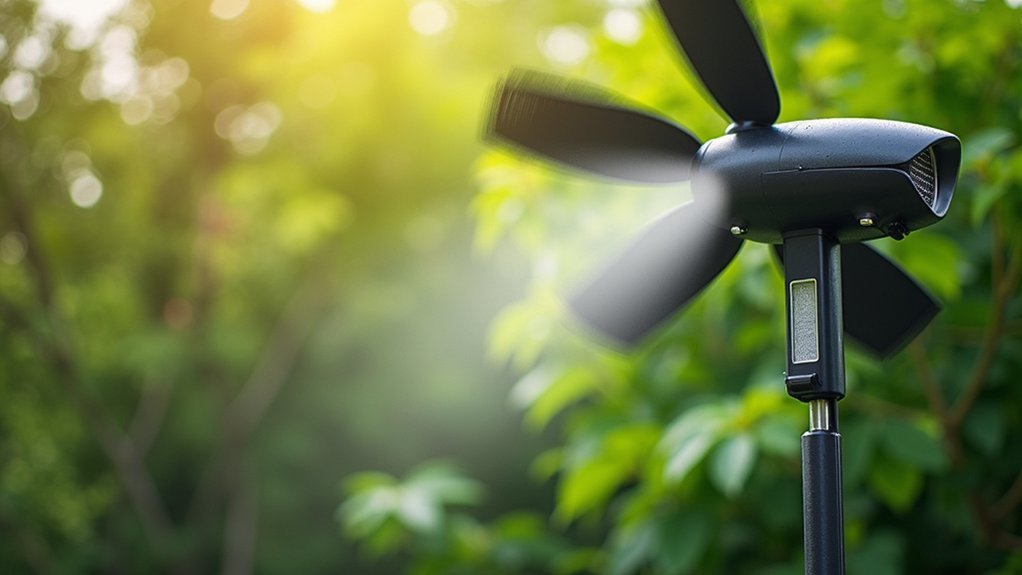
Why settle for constant mosquito swatting when the right outdoor fan can create a more enjoyable experience? For effective mosquito control, your fan type selection matters notably. Box, oscillating, and tower fans outperform ceiling models by producing stronger, more directed airflow that keeps mosquitoes at bay.
Look for fans with high CFM ratings—at least 1,000 cubic feet per minute guarantees sufficient air movement to deter these persistent pests. The oscillation feature is essential for covering larger areas evenly, preventing mosquitoes from finding unprotected spots to land.
Choose fans with multiple speed settings so you can adjust the intensity based on mosquito activity levels. Higher speeds prove more effective when these insects are particularly abundant. For extended outdoor gatherings, consider fans with lower noise levels for comfort without sacrificing protection.
CFM Ratings: Finding the Right Airflow Strength
When shopping for a mosquito-repelling fan, you’ll need to understand that CFM (cubic feet per minute) measures the volume of air movement, with 1,000+ CFM providing effective mosquito deterrence.
Your outdoor protection improves with higher CFM ratings because stronger airflow disrupts mosquitoes’ flight patterns and prevents them from landing on you.
For larger outdoor spaces, you might require multiple fans or models with particularly high CFM ratings to create a thorough mosquito barrier.
Understanding CFM Values
Airflow strength represents the cornerstone of an effective mosquito-repelling fan strategy. CFM (cubic feet per minute) measures the volume of air your fan can move, with higher ratings indicating stronger airflow capability.
For effective outdoor mosquito control, you’ll want fans with at least 1,000 CFM to create sufficient air movement that disrupts mosquito flight patterns.
The power of high-CFM fans extends beyond simply blowing mosquitoes away. These fans effectively disperse carbon dioxide—the primary attractant that draws mosquitoes to you—creating a protective barrier around your outdoor space.
When selecting outdoor fans, consider both the CFM rating and adjustable speed settings to optimize your defense. Remember that the fan’s size and type will determine its coverage area, so match your fan’s specifications to your specific outdoor environment.
Higher CFM Benefits
The benefits of high-CFM fans extend well beyond basic cooling functionality when it comes to mosquito control. When you choose outdoor fans with higher CFM ratings (at least 1,000), you’re investing in superior mosquito deterrence capability.
These powerful units create stronger airflow that effectively disrupts mosquitoes’ flight patterns, making it nearly impossible for them to land on you.
The increased airflow capacity serves a dual purpose—it not only creates a physical barrier against these pests but also disperses carbon dioxide that normally attracts them to you.
For larger outdoor spaces, this powerful air movement is particularly vital. When selecting your outdoor fan, match its CFM rating to your area size to guarantee you’re getting sufficient coverage for effective mosquito repelling results throughout your entire outdoor living space.
Combining Fans With Other Natural Mosquito Repellents
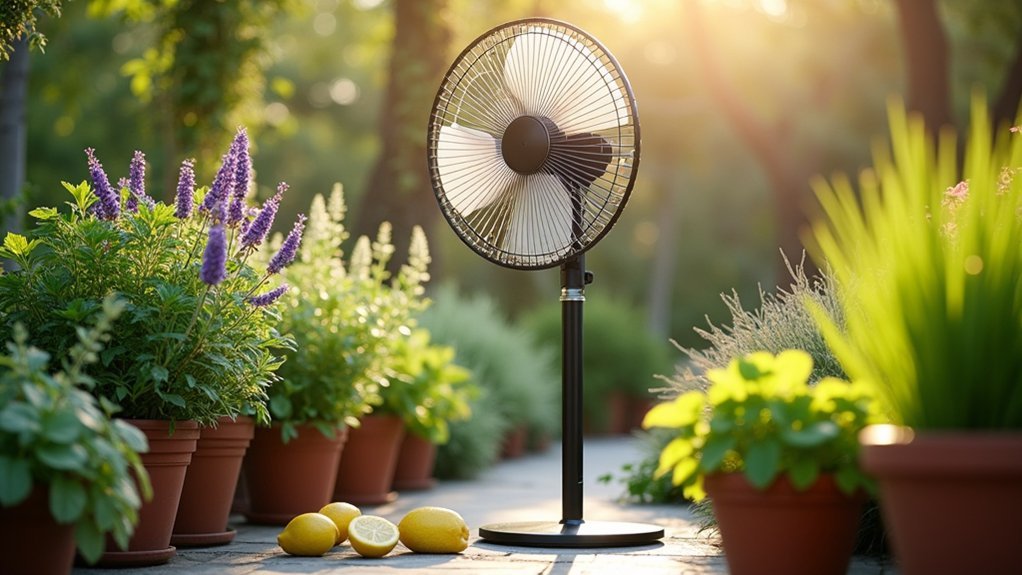
Creating a mosquito-free zone outdoors doesn’t have to rely on fans alone. When you combine outdoor fans with mosquito-repellent plants like citronella and lavender, you’ll create a more effective defense system. The airflow from fans helps distribute the natural repellents’ scents, masking the carbon dioxide and body heat that attract mosquitoes.
| Repellent Type | Works With Fans By | Effectiveness |
|---|---|---|
| Essential Oils | Dispersing scents widely | High when combined |
| Citronella Plants | Releasing oils into airflow | Moderate to high |
| Eucalyptus/Lemon Balm | Masking attractants | High in close proximity |
| Physical Barriers | Creating protected zones | Excellent with airflow |
This multi-faceted approach to mosquito control maximizes your outdoor comfort while reducing your reliance on chemical solutions. The strategic combination of fans and natural deterrents creates a thorough barrier that keeps these pests at bay.
Setting Up a Multi-Fan Defense System for Larger Areas
When hosting gatherings in spacious backyards or patios, a single fan simply won’t provide adequate mosquito protection. Instead, deploy multiple high-CFM fans (1,000+ CFM) strategically throughout your outdoor areas to create an effective mosquito barrier.
Protect your outdoor gatherings with multiple high-CFM fans strategically positioned to create an impenetrable mosquito barrier.
Combine oscillating fans with stationary models to achieve both wide coverage and concentrated airflow, disrupting mosquitoes’ ability to navigate and land.
Position units at different heights—tabletop fans for seated guests and pedestal models for standing areas—to maximize protection zones.
Create overlapping airflow zones by angling fans toward each other from opposite directions, eliminating dead spots where mosquitoes might find refuge.
You’ll need to adjust your setup based on evening wind patterns and mosquito activity, repositioning fans to maintain continuous airflow when conditions change.
Energy-Efficient Options for Season-Long Protection
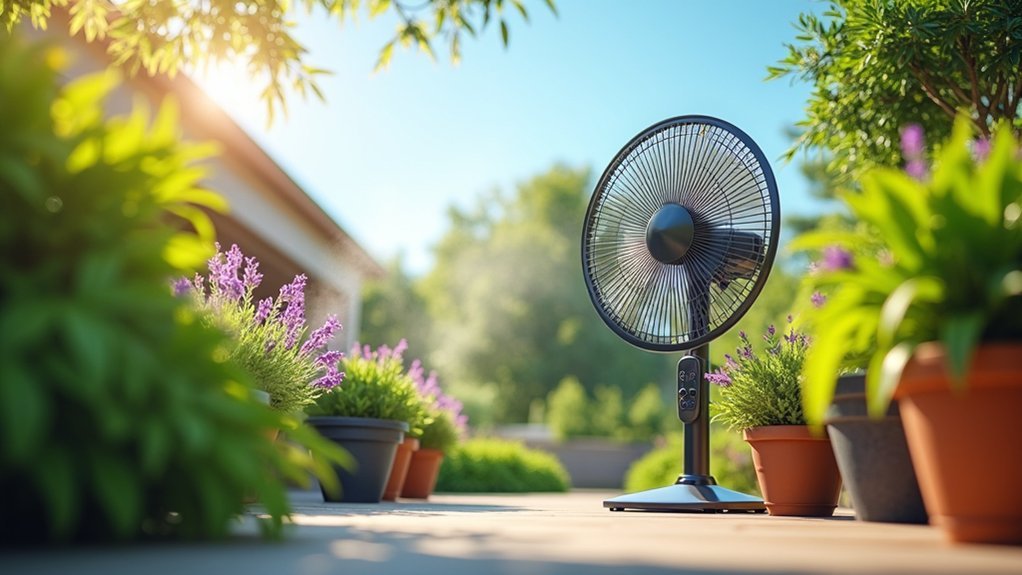
With multiple fans established for your outdoor defense system, maintaining sustainable operation becomes a key consideration.
Look for fans with higher CFM ratings that deliver powerful airflow while consuming less electricity, ensuring effective mosquito deterrence without inflating your utility bills.
Select models featuring variable speed settings so you can adjust output based on mosquito activity levels and outdoor conditions.
Today’s energy-efficient fans often include timers and eco-modes that optimize performance while minimizing power consumption during less active periods.
When choosing fans, prioritize weather-resistant materials that withstand summer elements without degradation.
This durability eliminates frequent replacements and contributes to long-term energy savings.
Weather Considerations for Outdoor Fan Effectiveness
Although outdoor fans provide reliable mosquito deterrence, their effectiveness fluctuates considerably with changing weather conditions. You’ll notice peak performance during calm days when the fan’s airflow can consistently disrupt mosquito flight patterns without interference.
| Weather Factor | Impact on Fan Effectiveness |
|---|---|
| Wind Conditions | Strong winds overpower fan airflow, reducing effectiveness |
| Humidity Levels | High humidity increases mosquito activity, challenging fan deterrence |
| Temperature | Cooler temperatures naturally decrease mosquito activity |
| Rainfall | Post-rain periods require increased fan usage as mosquitoes return |
During high humidity levels, mosquitoes become more active, making your outdoor fans work harder to repel them. Consider adjusting fan placement and speed based on daily forecasts. Remember that extremely windy conditions may render your fans less effective as the generated airflow becomes indistinguishable from natural breezes.
Real-World Success Stories of Fan-Based Mosquito Control
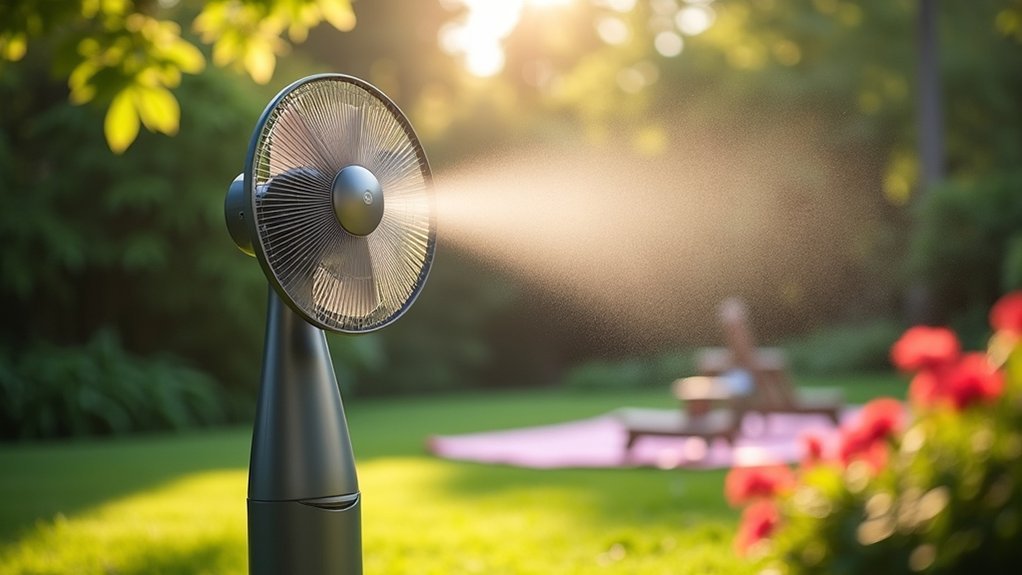
Homeowners across diverse geographic regions have documented remarkable success with fan-based mosquito control methods during outdoor gatherings.
In Texas, a family reported a 75% reduction in mosquito encounters after strategically placing outdoor fans around their patio during summer barbecues. Similarly, a Florida homeowner’s blog detailed how high-CFM fans kept mosquitoes away during evening pool parties that previously required chemical repellents.
Strategically placed fans reduced mosquito activity by 75%, offering a chemical-free alternative for outdoor entertaining.
Case studies from Michigan summer camps demonstrate how combining fans with basic mosquito habitat reduction created mosquito-free dining areas.
Real-world users consistently note that proper fan placement—directing airflow across gathering spaces—maximizes effectiveness.
One extensive pest management approach documented by a Georgia community garden involved solar-powered fans at seating areas alongside standing water removal, resulting in considerably improved volunteer participation during evening watering sessions.
Frequently Asked Questions
Will an Outdoor Fan Keep Mosquitoes Away?
Yes, outdoor fans will keep mosquitoes away. They’ll disrupt mosquito flight patterns and disperse carbon dioxide that attracts them. For best results, choose high-CFM fans with oscillation features and combine with other protective measures.
What Smell Do Mosquitoes Hate the Most?
Mosquitoes hate citronella, eucalyptus, and lavender scents the most. You’ll find they’re strongly repelled by marigold and basil too. Garlic and coffee grounds also effectively drive them away from your space.
Why Mosquitoes Don T Bite When Fan Is On?
Mosquitoes don’t bite when a fan’s on because they’re weak flyers. The airflow disrupts their flight, prevents them from landing on you, and disperses your CO2 breath they’d normally track.
How Do I Get Rid of Mosquitoes in My Fan?
To get rid of mosquitoes in your fan, unplug it first, then clean all components thoroughly with a damp cloth. Remove any debris from blades and housing. Keep the area around your fan free of standing water.
In Summary
You’ll find outdoor fans are a simple yet effective weapon in your mosquito-fighting arsenal. When you create consistent airflow, you’re disrupting the insects’ flight patterns and diluting the carbon dioxide signals they use to find you. Place your fans strategically, choose models with sufficient CFM ratings, and you’ll enjoy your outdoor space with considerably fewer buzzing intruders—all without chemicals or expensive repellent systems.





Leave a Reply